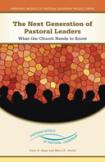Listen Up
Loyola Press. 160p $11.95 (paperback)
This is the fourth book from the Emerging Models of Pastoral Leadership Project. The project has three goals: provide solid research on parish pastoral leadership, stimulate conversation about the use of pastoral imagination to create vibrant parishes and explore ways in which national associations can collaborate to serve the church. The co-authors of this study, Dean R. Hoge and Marti R. Jewell, contribute significantly to fulfilling the first two goals, bringing scholarship and expertise to the task. The late Professor Hoge, a well-respected researcher, was a sociology professor at Catholic University for over 30 years. Jewell, assistant professor of theology in the School of Ministry at the University of Dallas, is the former director of the Emerging Models project.
The book begins with a look at shifting demographics in the church in the United States, and it is against this backdrop that the authors present the fruit of their labors. Hoge and Jewell conducted online surveys of young adult Catholics from across the country drawing from two groupings—college campus ministry programs and diocesan young adult lists—to get at their thoughts about faith and their attitudes toward the church, both positive and negative.
Readers familiar with studies of lay ecclesial ministry, pastoral leadership or the challenges of parish mergers will find little groundbreaking information here. But do not dismiss this book; it is well researched and worth reading. This study asks the next generation of pastoral leaders for their comments and opinions, and herein lies the book’s value. The authors are not talking about them, but rather with them. Respondents provide information and perspective for today’s church and the church of the future. The chapters maintain a balance between survey responses in table form and narrative provided by the interviewees.
Included in the survey are questions about vocations to the priesthood and vowed religious life. It becomes clear that respondents believe God’s call is not limited to these vocations. The young adults surveyed consider lay ministry to be a call from God too: thousands, in fact, are already answering that call, working in full-time lay ministry in parishes or diocesan positions. One respondent acknowledged that today’s young adults are second-generation lay ministers. Her parents’ generation, she comments, “paved the way.” Other young adults likewise refer to their parents’ involvement as volunteers and lay ministers in their parish. Young adults are dedicated to God and the church. They want to make a difference and want to serve. They expressed a firm belief that lay ministry is not a “stopgap” measure until priestly vocations increase. It is here to stay.
Some, however, cited reasons for not pursuing lay ministry—interest in another career, for example, a commitment to having a family and the low pay. “Interested in another career,” in fact, consistently came up in the responses. (The authors suggest that proposing lay ministry as a career option at an earlier age may have a positive impact.) The demanding schedule of parish work concerned several young adults, who spoke about wanting to spend time with a spouse and children. It is no surprise that low salary is also a deterrent. When asked, however, what issues they would bring to their bishops if given the opportunity, financial support came in next to last. Their primary concerns are for a better appreciation of and support for lay ministry, for more opportunities for spiritual development, greater financial support (this includes, in addition to salary concerns, funding for youth ministry and young adult ministry) and more credentialing.
Six administrators of lay training programs were also interviewed for the book. They unanimously agreed there is an adequate supply of candidates for available positions (with the possible exception of youth ministry positions) but acknowledged lay ministry does need more young people. They also noted a more conservative ecclesiology among today’s students.
The final chapter offers recommendations from the young adults. Heading the list is the need for more attention not only to their age group but to college students—advice that came from both ends of the ecclesiological spectrum. The insights they bring to bear can be valuable indicators to clergy and hierarchy of the shape of our church in the future.
The book concludes with three helpful commentaries that put the subject in clear perspective. Rachel Hart Winter, a doctoral candidate working at the Hank Center for the Catholic Intellectual Heritage at Loyola University Chicago, and Paul Jarzembowski, executive director of National Catholic Young Adult Ministry Association and full-time director of Young Adult Ministry for the Diocese of Joliet, Ill., speak from their own experience. Their words are heartfelt and their suggestions worthwhile. Edward Hahnenberg, who teaches theology at Xavier University in Cincinnati and was a consultant to the bishops’ Subcommittee on Lay Ministry, offers this insight: “If there is a single finding that summarizes this study, it is this: those young adults who are active in the Church find it easier to imagine staying active. So if our goal is to promote the Church leadership of tomorrow, we ought to be asking how we foster Church involvement today.”
Concluding that “research does not make decisions,” Hoge and Jewell have successfully achieved their stated goal “to provide reliable information to Church leaders to help them make decisions.” The task of interpreting the study’s findings is theirs.
This article also appeared in print, under the headline “Listen Up,” in the September 13, 2010, issue.








